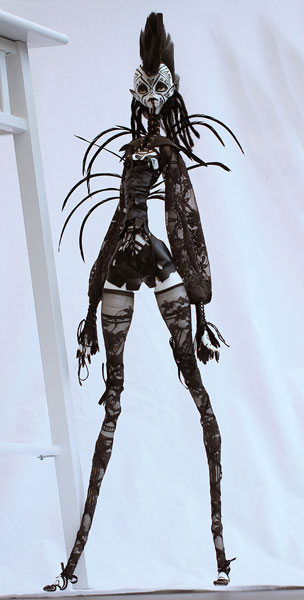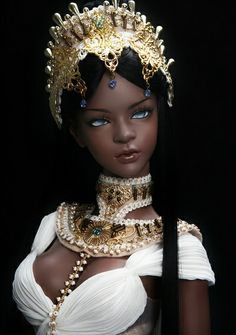Ball-Jointed DollsAn Introduction to the Ball-Jointed Doll Hobby |

What Makes a Ball-Jointed DollA typical ball-jointed doll is made of resin, has ball joints strung on elastic that allow posing, is anatomically correct, and has interchangeable eyes and wigs. Unlike most fashion dolls--such as Barbie or Monster Highs--a ball-jointed doll is intended to be fully customizable. Although they can often be purchased with face-ups, or painted faces, most ball-jointed dolls can be purchased blank and nude. Ball-jointed doll collectors are expected to modify everything about their dolls, from their paint jobs to their genders. Ball-Jointed Dolls Are Not ToysBall-jointed dolls appear to be toys, but several factors make them unsuitable for sustained play. Small, weak, protruding parts, such as ears or fingers, can be easily broken, resin is easily stained, and most dolls are sculpted with genitalia and nipples. Even if a parent doesn't mind these traits, the price tag--anywhere from a cool hundred to thousands of dollars--is usually deterrent enough. Common TerminologyBall-jointed dolls are called "bjds" for short. There are three common sizes in the bjd hobby: SD (Super-Dollfie), MSD (Mini Super-Dollfie), and tinies. Volks, the first bjd company, used "SD" and "MSD" as shorthand to refer to their dolls' sizes, and the rest of the community began to use them for all dolls that fell within those size ranges. These are blanket terms, however. For example, tinies can range from the height of a finger to the size of a Barbie doll, and MSDs might be 38-45" in height. Other helpful terms include "face-ups," "body blushing," "hybridization," and "artist dolls." "Face-ups" refer to the painting of a doll's face, and body blushing to the detailing of a doll's body. "Hybrids" are dolls that are cobbled together from different dollmakers. Usually hybrids are a doll head on a different body, but limbs can be interchanged, too. "Artist dolls" are dolls that are designed by a single artist rather than a company, and can include "artist casts"--or dolls made by the artists themselves and not factories. "Artist casts" usually have more errors than factory-made dolls, such as bubbling and inconsistent resin coloration.
CostCost is determined by the doll's size, resin color, accessories, face-up or body blushing, and costume. Even so, prices can fluctuate greatly. An SD and an artist cast MSD might both run for $700, despite the differences in size. A Trustworthy VendorOne of the most difficult challenges for a new hobbyist is finding a proper vendor. There is no one official site to buy a bjd, and companies pop up and disappear overnight. Actual doll companies often stand shoulder to shoulder with fraudulent sellers in Google listings. Knockoffs, or "recasts," are distressingly common. Recasts are intellectual property theft from the original artists, allegedly fund sweatshops, and sap trust from the secondhand market. Worst of all, recasts come with quality issues. These issues do not only include poorer workmanship, but dolls that are dangerous for one's health! Resin must be cured for a set amount of time before it is safe to handle. To cut costs, some recasters do not allow it to fully cure, and send dolls to their new owners "half-baked," as it were. These poorly-done dolls can literally poison the people who handle them! Therefore, it is in a new hobbyist's best interests to find seasoned veterans who can point out legitimate sites and secondhand sellers. Until a hobbyist can pick out suspicious posts by themselves, it is recommended that they avoid Ebay, Taobao, random Google searches, and Facebook sellers and only go through official sites or vetted posts on Den of Angels. Den of AngelsDen of Angels, or DoA as it is commonly called, is the world's foremost gathering of bjd enthusiasts. Not only is it a treasure trove of bjd history and care techniques, it has a stringently overseen marketplace where bjds and their accessories are bought and sold. All bjd discussions lead to DoA eventually, which make it an absolute must for any bjd fan! 
Face-Ups and Body BlushingThe most common kind of bjd modification is the face-up, or face-painting. It doesn't require the same level of skill as a physical modification or hybridization, and most hobbyists eventually try their hand at it. The products you use are ultimately up to you. However, common products include acrylic paint, soft pastels, and watercolor pencils. Note that all of these products are oil-free! No oil pastels or paints should ever be used on a bjd. Products can be applied using an airbrush or paintbrush. Paintbrushes are the most common tool as they are cheaper, but airbrushes can be quicker and the use of acrylic paint means that a face-up takes less work to be vibrant. Dolls should be primed and sealed with a proper sealant, such as Mr. Super Clear. Please use a half-mask respirator when using Mr. Super Clear and other aerosols as they have a cumulative effect on the lungs. EquipmentNecessary equipment for upkeep of one's dolls include extra elastic, a hemostat, and a pipe cleaner for restringing; proper material for storage, whether sturdy boxes or doll stands; sticky tac, preferably colorless, for fixing eyes in their sockets; a Magic Eraser for removal of scuffs and marks; and Remove-Zit for more stubborn stains. All cleaning products from Twin Pines of Maine are highly recommended. Caution! Do not use any materials that contain oils on your ball-jointed doll. It can seep into the resin and degrade it. Basic CareAll resin changes color over time, but that color change is accelerated by sunlight and heat. Dolls should remain in climate-controlled rooms away from windows and natural light. To reduce staining from clothes and wigs, do not store dolls with dark clothing long-term. If the doll must wear dark clothing for a long time, body stockings and wig caps can be used. It's a good idea to give doll clothes a careful cleaning to remove excess dye, if possible. To reduce the chances of chipping face-ups or leaving dirty fingerprints on a doll, avoid touching the face and handle the doll with cotton gloves. To keep wigs free from stray hairs and tangling, a toothbrush can be used as a comb. Special wig shampoo "Heads Up!" from Twin Pines of Maine is highly suggested. Do not ever use human hair products on doll wigs! These contain oils and other additives that can damage resin, face-ups, and artificial fibers. Always use doll stands with a free-standing doll, even those that balance well. If they fall they can damage fingers, faces, and face-ups. |
